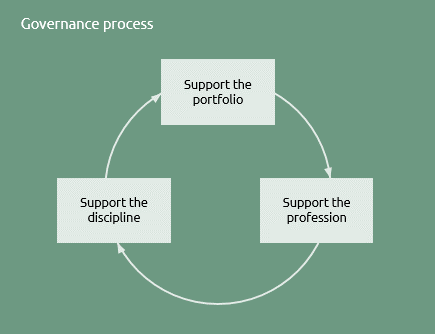This process brings together all the governance and professionalism functions and applies them across the portfolio. Its goals are to:
- provide sponsorship of the objectives of the portfolio;
- oversee assurance of the portfolio;
- promote the discipline and profession of P3 management.
It is misleading to show these functions as a process flow since they are all applied together throughout the life of the portfolio.
Each function is individually described in the functional framework. For the purposes of collecting them together within the portfolio governance process, they can be usefully viewed as three activities.
Click on the components of the diagram for more detail

Support the portfolio
This activity applies the functions that are concerned with the unique characteristics of each portfolio, namely:
- Sponsorship
-
Sponsorship of a portfolio covers similar aspects to the sponsorship of projects and programmes such as considering major authorisation requests and providing support to the people managing the portfolio.
In addition, portfolio sponsorship must champion the broader aspects of the discipline and profession of P3 management. The sponsor should be someone at Board level within the host organisation and represent P3 management in much the same way that a Finance Director or HR Director would represent their departments and professions.
- Infrastructure
-
The portfolio infrastructure is established to provide resources that perform the management process and the co-ordination process. This is often referred to as a PMO which is variously described as meaning a project management office, programme management office or a combination of both.
Where the portfolio is deemed to include the entirety of project and programme management within the host organisation, the infrastructure will include the systems and resources needed to support the profession and discipline of P3 management.
- Assurance
- Assurance is carried out at many levels, most of which will be within the portfolio. Some level of assurance will also be conducted that is external to the portfolio. This may include third party accreditation from professional bodies and be based on standards such as a capability maturity model.
Back to diagram
Support the profession
The profession of P3 management comprises its people and the way they apply the discipline. If a host organisation defines a single portfolio to encompass all of its projects and programmes, then that portfolio will be responsible for all activities that support the profession. If a large organisation defines multiple portfolios (perhaps on geographical or subsidiary company lines) then overall responsibility for supporting the profession may sit above the individual portfolios.
Where individual portfolios are large and do not share a common context, it may be that they are given responsibility for supporting the profession within their remit and there is no higher level co-ordination.
Supporting the profession involves applying the functions of:
- Communities of practice
-
The management of a portfolio will need to decide whether the benefits of communities of practice are best achieved by setting up local communities of practice, encouraging portfolio staff to be involved with external communities or a combination of both.
- Competence
-
The portfolio should establish and promote a framework to ensure that all members of staff can identify the competences that they will need at different stages in their career. The competence framework should be derived from the top level objectives that the portfolio must achieve and the values that the portfolio wants to promote.
- Ethics
-
A culture of ethical behaviour should be communicated, promoted and policed throughout the portfolio. As well as generally underpinning the working environment this may be designed to ensure that the portfolio conforms to legislation and regulation applicable to its context.
- Learning and development
-
A comprehensive approach to learning and development will incorporate various forms of training, coaching and mentoring. The approach should be based on the competence framework and ensure that every role within the portfolio is performed by someone with the necessary competencies.
- Back to diagram
Support the discipline
The discipline of P3 management comprises the tools, techniques and procedures that collectively make it distinct from other forms of management. Supporting the discipline of P3 management involves:
- P3 management
-
Although projects have been around for millennia and formalised P3 management has existed for decades, there is still a tendency in some organisations to see it as subordinate to other disciplines and unworthy of specific attention.
The portfolio must promote the clear benefits of a structured and disciplined approach to the delivery of projects and programmes.
- Knowledge management
-
The host organisation may already have knowledge management systems in place, in which case the portfolio simply needs to apply these to P3 management. If these do not exist then the portfolio must set up and maintain its own systems.
- Capability maturity
-
The portfolio should adapt the principles of capability maturity to create a model for organisational learning and development in much the same way that competencies are used to create a framework for individual learning and development.
The portfolio will monitor the development of project and programme management and may combine this with assurance. The portfolio may perform self-assessment of its own capability maturity.
The need for external assessment and certification depends upon whether this has commercial benefits for the host organisation.
- Life cycle
- The life cycle of projects and programmes acts as the skeleton on which process is built and methods defined. The portfolio must promote adaptable but consistent life cycles for its component projects and programmes. Through assurance, the portfolio will monitor the application of life cycle based processes.
Back to diagram





